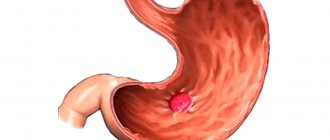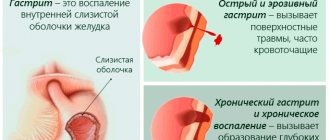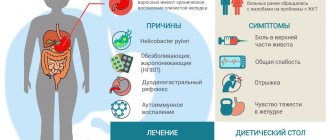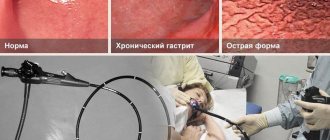Anacidic gastritis is a chronic inflammatory disease of the stomach that occurs against the background of a sharp decrease in the concentration of hydrochloric acid in the gastric juice. Some doctors call this disease “hypoacid”, but there is no such term in the International Classification.
Another synonym - “atrophic gastritis” - is outdated, since morphological studies have established the possibility of various damage to the mucosa and deeper layers, not only atrophy. In ICD-10, the disease is included in the group “Other gastritis” and is coded K29.6.0.
The disease is distinguished from gastritis by an initial chronic course. There is an opinion that the acute form is missed because it is either very transient or has secretive symptoms.
Prevalence of the disease
There is no exact information about the prevalence of anacid gastritis. According to medical statistics, all types of chronic gastritis account for about 90% of gastric pathology in the adult population. The hyperacid form is more common. Some scientists suggest that increased acidity is the initial form of the anacid state.
No association with gender was found in adults. Rare cases of the disease in children indicate that girls are predominantly affected, but by adolescence the incidence becomes the same as in boys. Anacidic gastritis is a pathology of mature people who have fully “tried” to violate all the principles of a healthy diet and lifestyle (smoking, alcoholism, physical inactivity, lack of balanced food).
The role of hydrochloric acid in the digestion process
Hydrochloric acid is an essential component of gastric juice. Without it, the process of digesting food is disrupted. In diagnosis, it is not the quantity that is measured, but the acidity indicator at the level of the basal (fundic) part of the stomach.
The unit of measurement is pH; fluctuations from 1.5 to 2 pH are considered normal. In the initial period of gastritis, the fluctuations are much greater. They are classified as functional disorders of the adequacy of acid production. Acidity drops significantly in the heat when a person drinks a lot of liquid. This is due to dilution of concentration.
The enzyme system of the stomach is designed so that it works only in a sufficiently acidic environment (pepsin). When the food bolus passes into the duodenum, neutralization occurs and the reaction changes to slightly alkaline.
Some people experience sharp fluctuations in pH levels at different times of the day.
Anatomically, the stomach is divided into 2 areas:
- fundic (bottom and body) - called acid-forming, since there are parietal and parietal cells that produce hydrochloric acid;
- antrum - where the process of neutralization by mucus occurs.
A decrease in acidity is possible only with a decrease in the number of parietal cells. Lack of hydrochloric acid causes disruption of pancreatic and intestinal enzymes. The synthesis of pancreatic juice depends on the activation of cells against the background of normal secretory activity of the stomach:
- in a hyperacid state, the secretion of enzymes that break down proteins is disrupted, this can lead to the development of autoimmune processes, allergic reactions, and hypersensitivity to foods;
- low acidity – does not allow the production of biochemically active components responsible for the absorption of minerals and vitamins; the body loses iron, magnesium, zinc, calcium, vitamin B12, which contributes to the development of chronic anemia (anemia).
It should be noted the disinfectant property of hydrochloric acid. At a sufficient level, it disinfects food. The deficiency causes the activation of rotting and fermentation processes, the proliferation of pathogenic pathogens that enter through the mouth.
This is confirmed in practice by the increase in intestinal infections in the summer during the hot period, when due to increased water consumption the acidity of the juice in the stomach is artificially reduced.
Causes
The specific cause of inhibition of the activity of gastric glandular cells is considered to be a genetic defect, which consists in suppressing the process of restoration of the mucous layer. It is caused by some internal or external irritant. This explanation is not sufficiently supported by research, but in practice it fully explains the hereditary predisposition in the family.
Another important reason is the lack of treatment for the hyperacid condition. Excessive acid production leads to overstrain and death of gland cells in the gastric mucosa. First, acidity normalizes, then drops.
Infection with Helicobacter pylori causes hyperacid gastritis, which first disrupts the restoration of the mucous membrane, and subsequently leads to epithelial atrophy and decreased acidity
A combination of these reasons is possible in the presence of provoking factors. The risk of hypoacid gastritis is significantly increased in people:
- addicted to spicy, fatty, roughly processed, fried, smoked foods, sweets, fast food;
- constantly abusing alcoholic beverages;
- smokers;
- not maintaining a diet (alternating long periods of fasting and subsequent overeating, eating dry food);
- with impaired chewing of food due to lack of teeth and dentures;
- working with occupational hazards in the form of toxic vapors, gases, liquids;
- in stressful situations;
- those who have not received full treatment for acute gastritis, gastroenteritis;
- long-term use of medications with an irritating effect on the gastric mucosa (corticosteroids, non-hormonal anti-inflammatory drugs, Aspirin and antipyretics, cytostatics, some antibacterial drugs).
It is necessary to take into account that anacid gastritis develops as a primary process against the background of general health, but can become a consequence of other diseases - secondary. Such diseases include:
- neuroses;
- pathology of the thyroid gland;
- damage to the digestive organs (chronic pancreatitis, hepatitis, colitis, cholecystitis);
- the presence of foci of infection in the form of chronic sinusitis, carious teeth, prostatitis in men, adnexitis in women;
- renal and liver failure;
- rheumatism;
- gout;
- infection by parasites, helminths, fungi.
Types of gastritis
Spicy
Acute gastritis is an acute inflammatory process in the gastric mucosa. It is often caused by the ingress of strong irritants into the cavity of the digestive organ - chemicals, large doses of alcohol, medications, poor-quality food contaminated with pathological microorganisms. It can occur against the background of other diseases, or due to an incorrect lifestyle. We can say that acute gastritis is more often caused by external (exogenous) factors.
Reference! Most of the patients who presented with acute gastritis had not previously suffered from gastrointestinal diseases.
Dyspeptic symptoms in the acute form can be more pronounced - sharp pain in the epigastrium, severe nausea, vomiting (sometimes dark brown or with blood).
Depending on the degree and nature of damage to the stomach tissue, there are 4 types of acute gastritis:
- Catarrhal . Characterized by redness and swelling of the internal walls of the organ. In this case, the structure of the gastric tissue is not damaged.
- Fibrinous. The presence of fibrin films on the gastric mucosa, which characterizes the severe course of the inflammatory process.
- Phlegmonous. Purulent inflammation of the mucous membrane.
- Corrosive. Ulceration and necrosis of stomach tissue.
How does the disease develop?
In the mechanism of acid formation disorders, the main role is played by the failure of adaptation of acid production to incoming food. As a result of dysfunction of the glandular epithelium, the supply of enzymes and food processing are delayed. The biochemical reactions that ensure the digestion process change qualitatively. Clinical symptoms appear that indicate gastric pathology.
A certain role is played by the decrease in the natural protection of glandular cells from the mucus-forming epithelium, this is facilitated by the entry into the stomach of too rough food and toxic substances. The initial overstrain of the parietal cells gradually leads to their death and atrophy. Therefore, gastroscopy reveals a picture of atrophic gastritis.
At the same time the following is violated:
- cell restoration process;
- formation of protective mucus;
- Insufficient blood supply is often detected against the background of hypertension and diabetes mellitus.
An important feature of chronic hypoacid gastritis is:
- primary damage to the fundus, where the acid-producing glands are most concentrated;
- rapid transition from their inflammation stage to atrophy;
- increased production of the gastrin enzyme due to the accumulation of undigested food (the more pronounced the atrophy, the higher the gastrin level);
- instead of new cells, connective tissue grows on the mucous membrane, which does not take any part in digestion;
- The gastric epithelium is partially replaced by intestinal cell types.
According to the results of fibrogastroscopic examination, 3 degrees of development of atrophic changes are distinguished:
- mild – about a tenth of the parietal cells are lost;
- medium - atrophic surface makes up from 10 to 20% of the stomach;
- severe - changes affect more than 20% of the glandular epithelium.
Symptoms and course
Hypoacid gastritis may not manifest any abnormalities for a long time. The initial signs are:
- feeling of fullness, heaviness in the epigastric zone after eating, even in the absence of excess;
- pain occurs immediately after eating, is localized in the epigastrium, and can radiate to the hypochondrium;
- belching of rotten contents with an unpleasant odor;
- nausea;
- increased production of saliva in the mouth;
- metallic taste;
- rarely heartburn.
The nature of the pain is aching, dull, relieved by inducing vomiting.
Secondary symptoms associated with damage to the intestines and other digestive organs include:
- alternating diarrhea and constipation;
- bloating of the intestines (flatulence) due to the activation of pathogenic flora and decay processes;
- hair loss and fragility;
- dry skin;
- increased fatigue, weakness;
- headache;
- tendency to lower blood pressure, palpitations;
- weight loss
It is noteworthy that the pain syndrome associated with acid deficiency is not associated with spastic contraction of the stomach muscles, but with its overstretching. It worsens with overeating, eating spicy foods, sauces, and fried foods. Secondary symptoms are caused by the formation of hypovitaminosis and anemia.
Exacerbations of gastritis with low acidity are observed in spring and autumn. They are provoked by alcohol intake, poor diet, and treatment of respiratory infections. Long periods of remission without clinical manifestations are possible.
Symptoms of anacid gastritis
In the early stages, anacid gastritis does not manifest itself with obvious symptoms. With a low level of stomach acidity, pathogenic microbes actively multiply in the intestines, so this gastropathology is often accompanied by acute intestinal infections, since the protective functions of the organ are weakened. In addition, the absorption of iron and protein is impaired, which leads to anemia.
As the pathological process progresses, the following signs of the disease appear:
- Grayish coating on the tongue.
- Feeling of heaviness in the stomach after eating.
- Abnormal bowel movements, diarrhea gives way to constipation.
- Putrid belching.
- Nausea, vomiting mixed with bile.
- Poor appetite.
- Flatulence.
- Pain in the epigastric region.
- Dizziness, fatigue, weakness.
If left untreated at the early stage of anacid gastritis, the symptoms intensify and the following appears:
- sudden weight loss;
- increased pain that becomes girdling;
- low blood pressure;
- tachycardia;
- anemia;
- yellowish tint of the skin;
- dry and brittle hair and nails;
- numbness of fingers and tongue;
- burning sensation;
- dysbacteriosis;
- cholecystitis or pancreatitis.
Features of anacid gastritis in childhood
In children, an acute form of gastritis most often occurs, with increased acidity. If an anacid state is detected in a child, one should think about a secondary lesion and look for the reasons.
Inflammation is often limited to a catarrhal nature without atrophy of glandular cells. Timely treatment can normalize digestion. One of the main reasons is poor diet. This is confirmed by maximum signs in the first years of school.
Uncontrolled consumption of carbonated drinks and chips, which irritate the gastric mucosa, leads to gastritis
In addition, the following are important:
- increased mental stress, stress;
- tendency to a hypoacid state in children under seven years of age due to underdevelopment of stomach function;
- increased possibility of infection entering through the stomach;
- limited physical mobility of the child due to various diseases.
Symptoms are expressed:
- in pain in the upper abdomen of varying intensity;
- loss of appetite;
- nausea;
- vomiting;
- abnormal stool;
- intolerance to dairy dishes;
- losing weight;
- irritability.
The causes of gastritis in children can be:
- various chronic infections, helminthic infestation;
- Giardia in the gallbladder;
- allergies to foods and medications;
- neuroendocrine disorders during adolescence;
- diseases of the liver and pancreas.
Gastritis actively develops if it is passed on in the family as a hereditary predisposition.
Symptoms and treatment of anacid gastritis: how to deal with zero acidity
Anacidic gastritis often develops after an acute form of the disease, sometimes it occurs as a result of dysentery or typhoid fever if not treated properly.
Anacidic gastritis is accompanied by stomach pain, vomiting, and gastrointestinal upset.
Symptoms and treatment of anacid gastritis will not darken your life if you exclude the factors that provoke the occurrence of the disease:
- regular overeating;
- frequent snacking;
- long breaks between meals;
- alcohol abuse;
- dry food;
- frequent consumption of spicy foods.
People who lead a sedentary lifestyle are at risk. This pathology can also be hereditary.
Before you learn more about the clinical picture of the disease, read detailed information about what anacid gastritis is.
Characteristics of different forms
Hypoacid gastritis occurs in different forms, which differ in the severity of symptoms and morphological changes detected on fibrogastroscopy.
Superficial gastritis
The decrease in hydrochloric acid production is mild. The wall of the stomach is somewhat thickened, dystrophy is regarded as moderate. Increased mucus production. Symptoms may be absent or detected by chance. A good effect is observed from following a diet and using folk remedies.
Erosive gastritis
The inflammation is hemorrhagic in nature, accompanied by severe circulatory disorders in the stomach and vascular changes. Often called:
- long-term drug therapy;
- alcohol abuse;
- Crohn's disease;
- respiratory infection.
If the cause is unknown, gastritis is called idiopathic.
Taking a large number of medications provokes the development of a pathological process
The gastric mucosa has increased bleeding due to vascular permeability. Patients show signs of bleeding:
- black chair;
- vomiting "coffee grounds";
- dizziness;
- weakness;
- heartbeat.
Antral gastritis
Most often it is of autoimmune origin or is a consequence of Helicobacter pylori parasitism. The pyloric part of the stomach undergoes atrophy. Connective tissue deforms the antrum and promotes the transition of inflammation to the intestines. The outlet from the stomach is narrowed due to tissue swelling and scarring.
The muscles spasm, which causes severe pain on an empty stomach. Patients complain of nausea and vomiting.
Hypertrophic gastritis
Against the background of a lack of hydrochloric acid, the tissue of the mucous and even the muscular layer grows with the formation of single or multiple neoplasms. A lot of mucus is released. During an exacerbation, the patient experiences diarrhea, nausea, and slight pain in the upper abdomen. The polypous form is characterized by a tendency to degenerate into a malignant tumor.
What is the disease
This pathology is considered quite serious. When anacid gastritis occurs in the stomach, the secretion of hydrochloric acid ceases due to atrophic processes in the mucous membrane of this organ.
It should be noted that the role of this substance in the functioning of the stomach is enormous; without hydrochloric acid it is impossible to perform several functions.
Hydrochloric acid is needed:
- for normal peristalsis;
- to destroy all pathogenic organisms that enter the stomach with food;
- for active participation in protein processing.
As a result of atrophic changes in the mucosa, its areas begin to be replaced by epithelium of intestinal origin, which can also provoke the development of oncological processes in this area.
A person suffering from this pathology cannot live a full life; he is tormented by pain and discomfort in the stomach area. There are many reasons for the development of this disease; there are also other ailments that provoke the appearance of such stomach problems.
How is diagnosis carried out?
Based on clinical manifestations, it is impossible to distinguish between hyper- and hypoacid gastritis. Therefore, the main importance is attached to analyzes and hardware examination. Patients are prescribed:
- Esophagogastroduodenoscopy - insertion of a probe with an optical device allows you to examine the esophagus, all parts of the stomach and duodenum, and take mucosal material for biopsy.
- pH-metry is carried out during fibrogastroscopy with a special probe or radiocapsule.
When examining biopsy specimens, not only Helicobacter is revealed, but also the extent of its spread throughout the mucous membrane.
The main method for diagnosing the form of gastritis, the presence of complications and cancerous degeneration
If it is impossible to perform intragastric intubation, the acidity of the gastric juice is judged by the level of uropepsinogen in daily urine, as well as by the concentration of serum gastrin (in case of insufficient acid formation, it is increased, in cases of antral atrophic gastritis, it is sharply reduced). Morphological studies provide a more complete analysis of the capabilities of the fundic glands and the degree of atrophic changes.
Helicobacter pylori infection is confirmed by the detection of special antibodies in the blood of patients. In clinics, an x-ray method is used, which makes it possible to identify polypous growths, deformities of the antrum, tumors, and impaired folding. Ultrasound is a low-information method for detecting stomach diseases, but it helps to identify other pathologies of the digestive organs.
Treatment
The treatment regimen is prescribed individually depending on:
- from morphological changes in the mucosa;
- concomitant damage to the entire digestive system;
- degree of acidity reduction.
Goals of therapy:
- reduction of inflammatory phenomena;
- achieving a long period of remission;
- slowing down the atrophy process;
- restoration of normal secretory activity of the stomach;
- ensuring proper digestion of food and absorption of its components.
Diet food
Diet and nutritional regimen are of great importance in therapy. It is recommended to eat small amounts of food 6 times a day, always warm and in a sufficiently crushed form. This allows you to relieve the stomach from unnecessary trauma and reduce the load on the secreting cells.
Table #2 is usually recommended. It involves the inclusion of foods that stimulate acid function and appetite:
- boiled, steamed, pureed meat and fish dishes;
- porridge;
- vegetables;
- fruits;
- greenery.
Boiled fish is an excellent dish option for a sick person’s menu.
It is necessary to exclude:
- spicy seasonings;
- fatty foods;
- cold and hot drinks;
- fresh baked goods.
For frequent diarrhea, table No. 4 is prescribed; if pancreatitis becomes the leading pathology, table No. 5 is prescribed.
Causes and treatment of anacid gastritis
35–40% of the adult population. The cause of problems with this organ of the digestive tract is increased or decreased secretion production, provoked by an unhealthy diet, drinking alcohol and other factors.
What is anacid gastritis
A characteristic feature of this disease is a reduced level of hydrochloric acid. As a result of anacid gastritis, the lining of the stomach atrophies, its individual sections are replaced by intestinal epithelial tissue. The pathology is dangerous due to the possible development of a malignant tumor.
Causes and signs of the disease
Anacidic gastritis most often develops in patients with chronic damage to the walls of the stomach in the acute stage, when the cells of tissues damaged as a result of increased acidity cease to recover. Often, impaired secretion production is a consequence of previous diseases: typhoid fever, dysentery.
Helicobacter pylori infection is considered another factor that provokes inflammatory processes and leads to a decrease in acidity. Other causes of hypoacid gastritis include:
- sedentary lifestyle;
- frequent snacking;
- binge eating;
- too long breaks between meals;
- an abundance of spices and spicy dishes in the diet;
- alcohol abuse;
- smoking.
Scientists were able to find out that gastritis with atrophy of the mucous membrane can be inherited. The disease is increasingly affecting young people suffering from physical inactivity. Treatment of the pathology must begin as quickly as possible when the first symptoms of anacid gastritis appear:
- weakness, severe headaches;
- gray-white coating on the back of the tongue;
- lack of desire to eat food, sudden decrease in body weight;
- belching, unpleasant odor from the mouth;
- feeling of heaviness, abdominal pain after eating;
- increased gas formation;
- diarrhea;
- aversion to protein-rich foods.
When the production of hydrochloric acid decreases, the protective functions of the stomach weaken, as a result of which pathological bacteria begin to actively multiply. As a result of disruption of the process of assimilation of important microelements, the patient’s body does not receive nutrients in the required amount.
How does the disease manifest itself?
In the initial stages of anacid gastritis, patients complain of discomfort after eating. Acute vitamin deficiency gradually develops, hemoglobin levels decrease, and conditions caused by a lack of various microelements are observed. The patient's immunity sharply deteriorates, chronic fatigue and lethargy appear.
Due to the lack of desire to eat food in the proper amount, a person loses a lot of weight. In the absence of timely treatment of anacid gastritis, the body is affected by other serious diseases - pancreatitis, cholecystitis, dysbacteriosis. Modern examination methods help identify the presence of pathology:
- measuring the pH level of the gastric mucosa;
- biochemical and general blood tests;
- X-ray;
- biopsy of gastric tissue;
- taking a puncture of cerebrospinal fluid to diagnose anemia;
- examination of the stomach contents to identify pathogenic bacteria.
Such diagnostic measures make it possible to determine the degree of tissue damage in atrophic gastritis. The main manifestations of the disease and examination results are taken into account when prescribing therapy.
Dangerous consequences
A normal level of hydrochloric acid maintains the gastric mucosa in proper condition to ensure the process of digesting food and counteracting various microbes.
When secretion production deteriorates, bacteria begin to actively spread, entering other organs through a weakened barrier. This condition leads to severe damage to the gastrointestinal tract.
The most serious complication of anacid gastritis is tissue rejection and their gradual replacement by intestinal epithelium. This process can trigger the development of malignant tumors. Patients with atrophic gastritis undergo regular examinations to detect cancer.
Treatment and preventive measures
Treatment for anacid gastritis is possible only after visiting a gastroenterologist, who will study the results of examinations and prescribe a course of medications. The essence of treatment is to restore the natural level of acidity and eliminate the unpleasant symptoms of the disease. For this pathology, the following medications are used:
- to compensate for the lack of hydrochloric acid - Trienzyme, Pepsidil;
- to restore the digestive process - Pentamin;
- to eliminate diarrhea - Smecta, activated carbon;
- for dysbacteriosis - Linex, Duphalac;
- for the prevention of constipation - Senade, Fitomucil.
DrugPhotoPrice
| Pentamin | from 1749 rub. |
| Smecta | from 70 rub. |
| Linex | from 330 rub. |
| Duphalac | from 310 rub. |
| Senade | from 549 rub. |
Often, patients with atrophic gastritis have to take medications throughout their lives. As a supplement to the main therapeutic course, doctors prescribe immunostimulants.
As a traditional medicine, it is recommended to use a decoction of dry plantain leaves or the juice of the plant with its roots, passed through a filter and boiled, ground in a blender. No less effective in the treatment of anacid gastritis is a preparation made from white cabbage. The juice is prepared in a similar way by passing the leaves through a meat grinder. Take 100 ml per day orally.
To prevent exacerbations of this chronic disease, it is necessary to lead a more active lifestyle, stop smoking and drinking alcohol. It is necessary to follow the correct diet, exclude snacks on the run, and dry food. It is important to pay special attention to oral hygiene.
Diet for atrophic gastritis
A prerequisite for the treatment of pathology is a change in diet, avoiding fatty, fried, and spicy salty foods. Patients are allowed to use:
- steamed meat and fish dishes;
- cereals;
- pasta;
- sour cream and fermented milk products;
- heat-treated fruits and vegetables;
- butter and vegetable oil;
- unhealthy bakery products;
- fruit or berry compotes;
- jelly;
- tea, coffee of moderate strength.
Portions should be small, meals should be taken 5-6 times during the day. It is not recommended to eat too hot or cold foods. Boiled eggs, kvass, carbonated drinks, alcohol, legumes, fatty meat, salted or smoked fish are completely excluded. Such a diet is designed to restore the normal level of hydrochloric acid in case of anacid gastritis.
Damage to the gastric mucosa is a common problem. It is important to begin treatment of such a pathology as anacid gastritis when the first alarming signs appear. To prescribe a therapeutic course, a doctor's consultation is necessary. Self-treatment can lead to the development of cancer and other complications.
: Anacidic gastritis
Source: https://dispanseri.ru/alkogol-i-bolezni/anatsidnyj-gastrit.html










